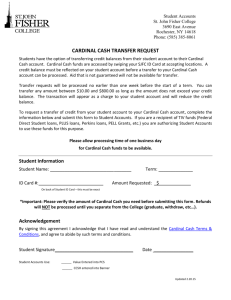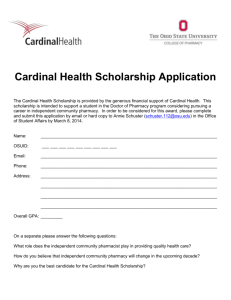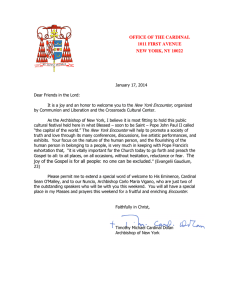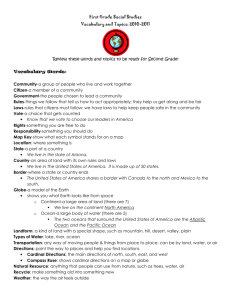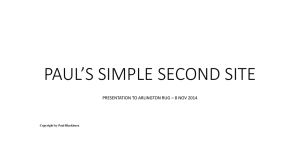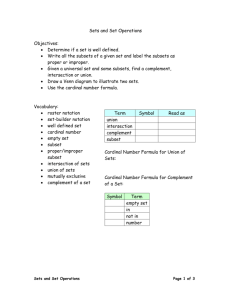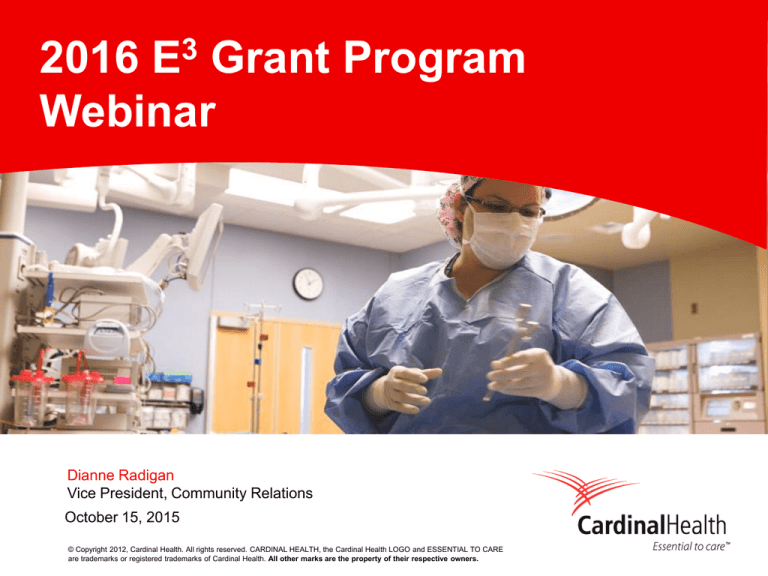
3
E
2016
Grant Program
Webinar
Dianne Radigan
Vice President, Community Relations
October 15, 2015
© Copyright 2012, Cardinal Health. All rights reserved. CARDINAL HEALTH, the Cardinal Health LOGO and ESSENTIAL TO CARE
are trademarks or registered trademarks of Cardinal Health. All other marks are the property of their respective owners.
Webinar Logistics
• Please put your phone on mute until you are ready to
talk.
• Please do not put your phone on hold.
• If you need assistance during the conference, press #
for a list of menu options.
2
© Copyright 2012, Cardinal Health. All rights reserved. CARDINAL HEALTH, the Cardinal Health LOGO and ESSENTIAL TO CARE
are trademarks or registered trademarks of Cardinal Health. All other marks are the property of their respective owners.
Agenda
•
•
•
Logistics for the call
Overview/goals for the webinar
Very brief history of the E3 grants and Cardinal Health
Foundation’s commitment to fostering excellence in
healthcare and accelerating the rate of change
Focus on outcomes and sharing
Resources available
Grant criteria
•
•
•
–
–
–
–
•
3
Eligibility
Content
Scoring
Tips
Questions
© Copyright 2012, Cardinal Health. All rights reserved. CARDINAL HEALTH, the Cardinal Health LOGO and ESSENTIAL TO CARE
are trademarks or registered trademarks of Cardinal Health. All other marks are the property of their respective owners.
Goals for the Webinar
• Help potential applicants send the very best proposal
that is responsive and compelling
• Answer any and all questions
• Open the door for additional communication
4
© Copyright 2012, Cardinal Health. All rights reserved. CARDINAL HEALTH, the Cardinal Health LOGO and ESSENTIAL TO CARE
are trademarks or registered trademarks of Cardinal Health. All other marks are the property of their respective owners.
History of E3 Patient Safety Grants
Goal:
Provide resources to help hospitals, systems, clinics
and collaboratives provide the very best care for
patients – improve healthcare efficiency,
effectiveness and excellence and save days, dollars
and lives. To help accelerate the rate of change.
$8m since 2008 for improvement projects
Level of support: $7.5k-50K
Areas of focus have narrowed each year
•
Medication use in transitions to ‘home’
•
Spread of successful efforts
•
Engaging patients and their families
Saving days, dollars and lives
5
© Copyright 2012, Cardinal Health. All rights reserved. CARDINAL HEALTH, the Cardinal Health LOGO and ESSENTIAL TO CARE
are trademarks or registered trademarks of Cardinal Health. All other marks are the property of their respective owners.
E3 Outcomes
Antelope Memorial Hospital decreased medication error rates by
50%, and near miss rate by 52% implementing electronic medical
records, Pyxis dispensing systems, medication reconciliation, and
computerized physician order entry.
Centrastate Medical Center demonstrated a 60% reduction in
nursing interruptions by wearing white vests reading "Please do not
interrupt while passing medications", leading to potential avoidance
of medication administration errors.
Christian Hospital Northeast addressed antibiotic therapy and
resulted in a savings of $148k.
Cleveland Clinic Foundation implemented video technology
education in their anticoagulation clinic and saved $44,400/year /
100 new patients / month.
Clovis Community Medical Center utilized a pharmacy technician
for medication reconciliation and demonstrated dramatic increases
in the number of complete home medication regimens documented
and also improved physician and pharmacist confidence in the
accuracy of home medication lists.
El Rio Community Health Center pharmacists were provided
patient diagnosis information during review of electronic
prescription orders, leading to identification of 52 prescribing
problems in 9 days with 7 significant interventions made.
FirstHealth Moor Regional Hospital Scripted hourly rounding,
decreased the use of nursing call bell usage, decreased the number
of patient falls, and increased patient satisfaction scores.
Forsyth Medical Center Foundation implemented a medication
reconciliation project and reduced 30 and 60-day readmission by
9.7 and 15.8% saving $363k.
6
HealthAlliance of the Hudson Valley used risk reduction
strategies that lead to zero wrong-site surgeries or
incorrect invasive procedures performed in the last two
years through the performance of Failure Modes and
Effects Analysis and the use of Six Sigma – Lean.
Health Care Improvement Foundation hospitals and the
Institute for Safe Medication Practices initiated
interventions to reduce medication errors involving
hydromorphone resulting in an estimated cost savings
ranging from $82,708 for significant ADEs to $235,364 for
life-threatening ADEs.
Holy Spirit Health System decreased operating room
turnover time between surgeries by 53% (from 32 to 17
minutes) resulting in a cost savings of $1,394,280.
Inova Health Care Services implemented MRSA
presurgery screening and reports saving between $225450k
Kansas University implemented pharmacist discharge
planning and reduced readmission from 26% to 16.2%.
Lahey Clinic reduced related CHF readmissions by 25%
in one year, due in part to improving communications with
patients and families, and focusing on medications at
discharge.
Lee Memorial implemented an asthma mgt. program and
reports reducing ED visits 86% and loss of days of school
or work by 64%.
© Copyright 2012, Cardinal Health. All rights reserved. CARDINAL HEALTH, the Cardinal Health LOGO and ESSENTIAL TO CARE
are trademarks or registered trademarks of Cardinal Health. All other marks are the property of their respective owners.
E3 Outcomes
Maine Memorial reports a savings of $100k after
implementing a standardized discharge planning and med.
rec. process.
Memorial Sloan-Kettering Cancer Center participants who
received a communication-based intervention reported
increased self-efficacy related to communicating patient
safety concerns, and improved their scores in the
communication domain of the AHRQ Patient Safety Culture
Survey.
Nationwide Children’s Hospital prevented 427 harmful
adverse drug events and avoided $2,000,053 in
unnecessary hospital costs in its critical care units since
February 2010 via implementation of medication
reconciliation, infusion pump programming, and independent
double checks.
National Coalition for Cancer Survivorship trained over
150 health care professionals about oral adherence, barriers,
motivational interviewing and other best practices leading to
improved oral chemotherapy monitoring.
Niagara Falls Memorial Medical Center’s Bedside
Medication Administration system reduced medication errors
by 57% in 2011 and has continued to decrease by 27% in
2012 with an estimated savings of $102.5k.
Rhode Island Hospital studied error rates of surgical sitemarking in the operating room and found there would be less
opportunity for error when compared to pre-op site-marking.
Rush University Medical Center identified hospital patients
at high risk for readmission and intervened with medication
management and psychosocial counseling, leading to
decreased readmission rates and savings of $50,000.
7
Saint Alphonsus Family Maternity Center paired
TeamSTEPPS® with scripted simulation exercises to train Csection surgical team members in a universal
communications platform, increasing understanding of
Universal Protocol by 35%, and advancing patient safety in
the OB OR by supporting previously unacquainted clinicians
to serve as “interchangeable” members of a Universal
Surgical Team.
Scripps Health implemented system-wide glycemic controls
and reports saving $2m from reduced lengths of stay.
Suburban Hospital addressed and tracked the effectiveness
of medication processes throughout the inpatient stay as well
as medication reconciliation at discharge, before the transition
to a long term care facility
The Wellmont Foundation implemented a pharmacy
technician-based medication reconciliation program at Bristol
Regional Medical Center that demonstrated a direct cost
savings due to labor cost and efficiency ($59,900 per year).
Pharmacy technicians performed more accurate medication
reconciliation than nurses and more accurately reconciled
home medications (finding more than 4,200 medication
variances).
Wayne State University introduced Electronic Medication
Alert Systems for computerized physician order entries in a
pediatric emergency department, leading to an overall
reduction rate per 100 prescriptions and made changes to
19.5% of the prescriptions that generated a drug range
checking alert, preventing harm from reaching the patient.
9.7 and 15.8% saving $363k.
© Copyright 2012, Cardinal Health. All rights reserved. CARDINAL HEALTH, the Cardinal Health LOGO and ESSENTIAL TO CARE
are trademarks or registered trademarks of Cardinal Health. All other marks are the property of their respective owners.
Focus on Sharing
Examples of publications / presentations
•
•
•
•
•
•
•
•
•
8
Nationwide Children’s presented on formula prep for children with severe medical needs at
the Pediatric Nutrition Managers Conference.
Healthcare Improvement Foundation published “The costs of adverse drug events in
community hospitals.” Joint Commission journal on quality and patient safety
Inova Health presented at numerous venues including Seventh Annual Sigma Theta Tau
meeting, Washington Regional Nursing Research Consortium and IHI’s Annual Forum
Pasadena Hospital Assoc. presented at the Nat’l Assoc. of Neonatal Nurses
St. John Hospital presented at APIC and ICAAC (Interscience Conf. for Antimicrobial Agents
and Chemotherapy
CDC website – Barnes Christian NE for antimicrobial stewardship
Joint Comm. Journal on Quality and Safety – Univ. of New Mexico
Piedmont Hospital presented and published at the Society of Hospitalist Medicine and Visiting
Nurse Health Systems
Wayne State University presented as a poster at the Pediatric Academic Societies Meeting in
Boston, May 2012
© Copyright 2012, Cardinal Health. All rights reserved. CARDINAL HEALTH, the Cardinal Health LOGO and ESSENTIAL TO CARE
are trademarks or registered trademarks of Cardinal Health. All other marks are the property of their respective owners.
Resources Available in 2016
• $1M from the Cardinal Health Foundation
• A major change in 2016 is to invite multi-year grants
• We anticipate 15-20 grants up to $50k per year for up to three
years
– Requests / budgets should not exceed $50k
– Please describe source of funding for additional project expenses
• Invitation to join a learning network and / or a convening of
grantees over the course of the one to three years of the effort
9
© Copyright 2012, Cardinal Health. All rights reserved. CARDINAL HEALTH, the Cardinal Health LOGO and ESSENTIAL TO CARE
are trademarks or registered trademarks of Cardinal Health. All other marks are the property of their respective owners.
Grant Criteria - Eligibility
• Tax exempt 501(c)(3) organizations
• Typically, hospitals, systems, clinics, collaboratives,
ambulatory settings
–
Include letters of commitment for any partner organizations
• Applicants can be in the acute or ambulatory setting
• If previously funded, a final report or update on workin-process should be submitted
10
© Copyright 2012, Cardinal Health. All rights reserved. CARDINAL HEALTH, the Cardinal Health LOGO and ESSENTIAL TO CARE
are trademarks or registered trademarks of Cardinal Health. All other marks are the property of their respective owners.
Grant Criteria - Content
Very focused on three areas:
• Medication safety across transitions of care from the
acute setting to the community/home.
• Spreading previously successful work within an
institution to other settings – to an entire system,
community or state.
• Engaging patients and their families in their care.
11
© Copyright 2012, Cardinal Health. All rights reserved. CARDINAL HEALTH, the Cardinal Health LOGO and ESSENTIAL TO CARE
are trademarks or registered trademarks of Cardinal Health. All other marks are the property of their respective owners.
Grant Criteria - Scoring
0-5 points
Cover letter
0-80 points
Description of the program
• Previous experience
• Specific objectives
• Driver diagram
• Timeline
• Outcomes anticipated
• Letters of commitment for partner
organizations (not included in 5 page
limit)
Budget (no Cardinal Health products should be
a part of the request)
0-15 points
12
© Copyright 2012, Cardinal Health. All rights reserved. CARDINAL HEALTH, the Cardinal Health LOGO and ESSENTIAL TO CARE
are trademarks or registered trademarks of Cardinal Health. All other marks are the property of their respective owners.
Grant Criteria - Tips
• Focus on implementing best practices or spread of
previously successful efforts
• Be very specific about
– Previous experience
– Baseline data
– Protocols
– Outcomes anticipated
• Include a timeline that addresses all aspects of the
work including IRB approval, if needed
• Quantify anticipated outcomes in terms of days, dollars
and lives potentially saved
13
© Copyright 2012, Cardinal Health. All rights reserved. CARDINAL HEALTH, the Cardinal Health LOGO and ESSENTIAL TO CARE
are trademarks or registered trademarks of Cardinal Health. All other marks are the property of their respective owners.
Additional Opportunity in 2015
• American Society of Health-System Pharmacist and Cardinal Health
Medication-Use Safety Award
– This award honors a pharmacist-led multidisciplinary team for its significant institution-wide
system improvements related to medication-use. Three hospitals are recognized with the
‘winner’ receiving a $50,000 award and the two finalists a $10,000 award.
– Letter of intent due December 11, 2015
For more information www.cardinalhealth.com/community
14
© Copyright 2012, Cardinal Health. All rights reserved. CARDINAL HEALTH, the Cardinal Health LOGO and ESSENTIAL TO CARE
are trademarks or registered trademarks of Cardinal Health. All other marks are the property of their respective owners.
Q&A
15
© Copyright 2012, Cardinal Health. All rights reserved. CARDINAL HEALTH, the Cardinal Health LOGO and ESSENTIAL TO CARE
are trademarks or registered trademarks of Cardinal Health. All other marks are the property of their respective owners.
Thank you!
16
© Copyright 2012, Cardinal Health. All rights reserved. CARDINAL HEALTH, the Cardinal Health LOGO and ESSENTIAL TO CARE
are trademarks or registered trademarks of Cardinal Health. All other marks are the property of their respective owners.

